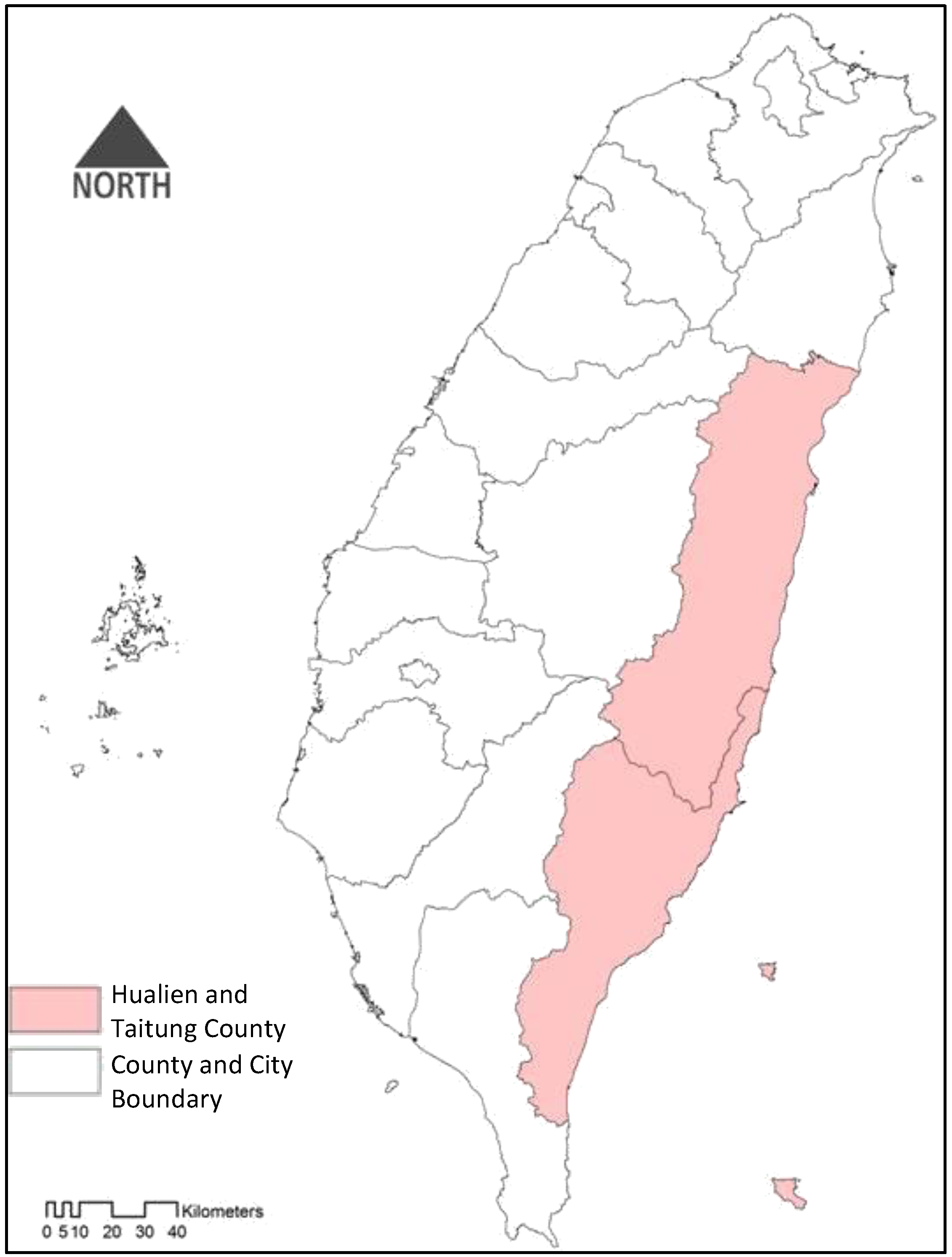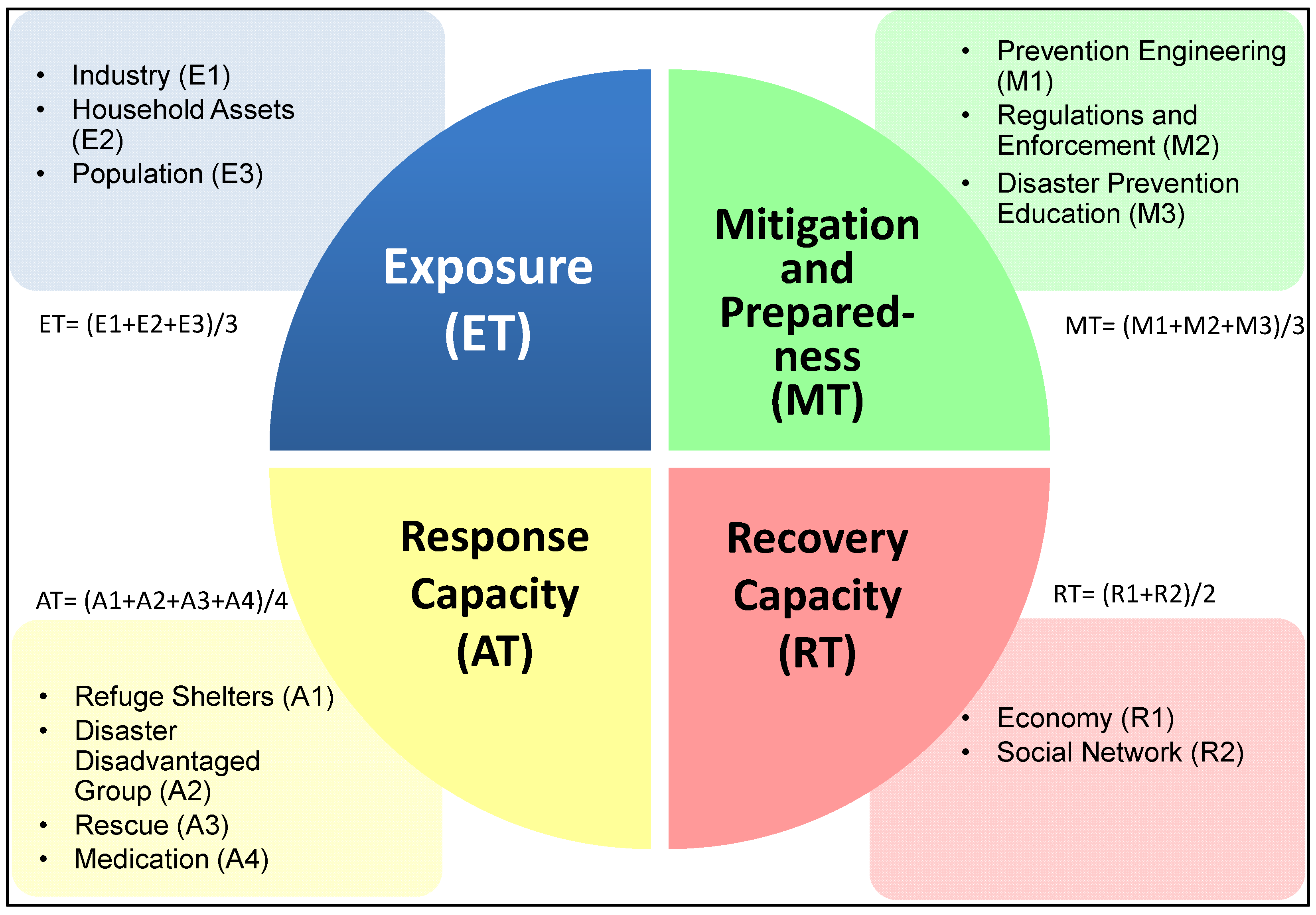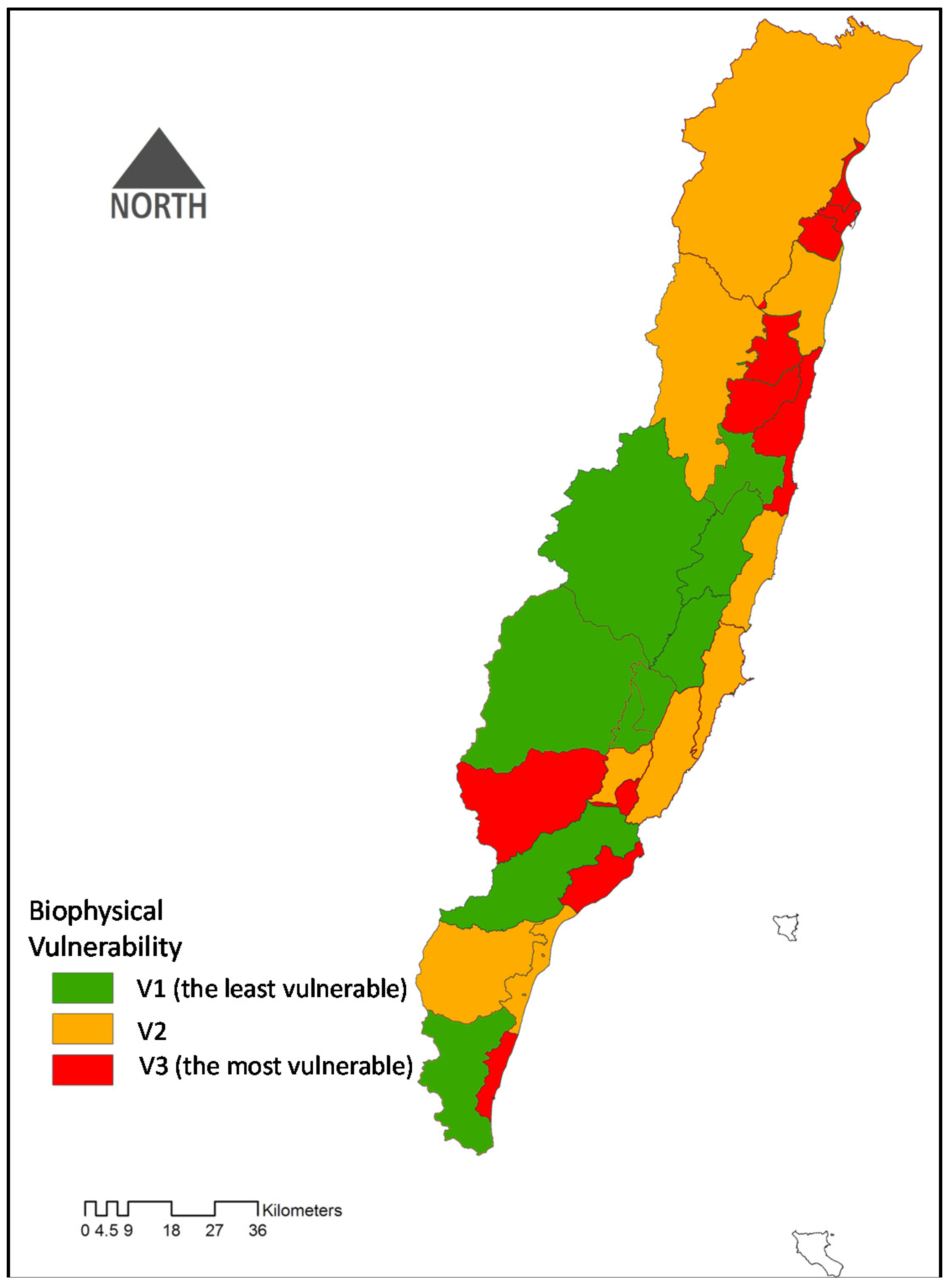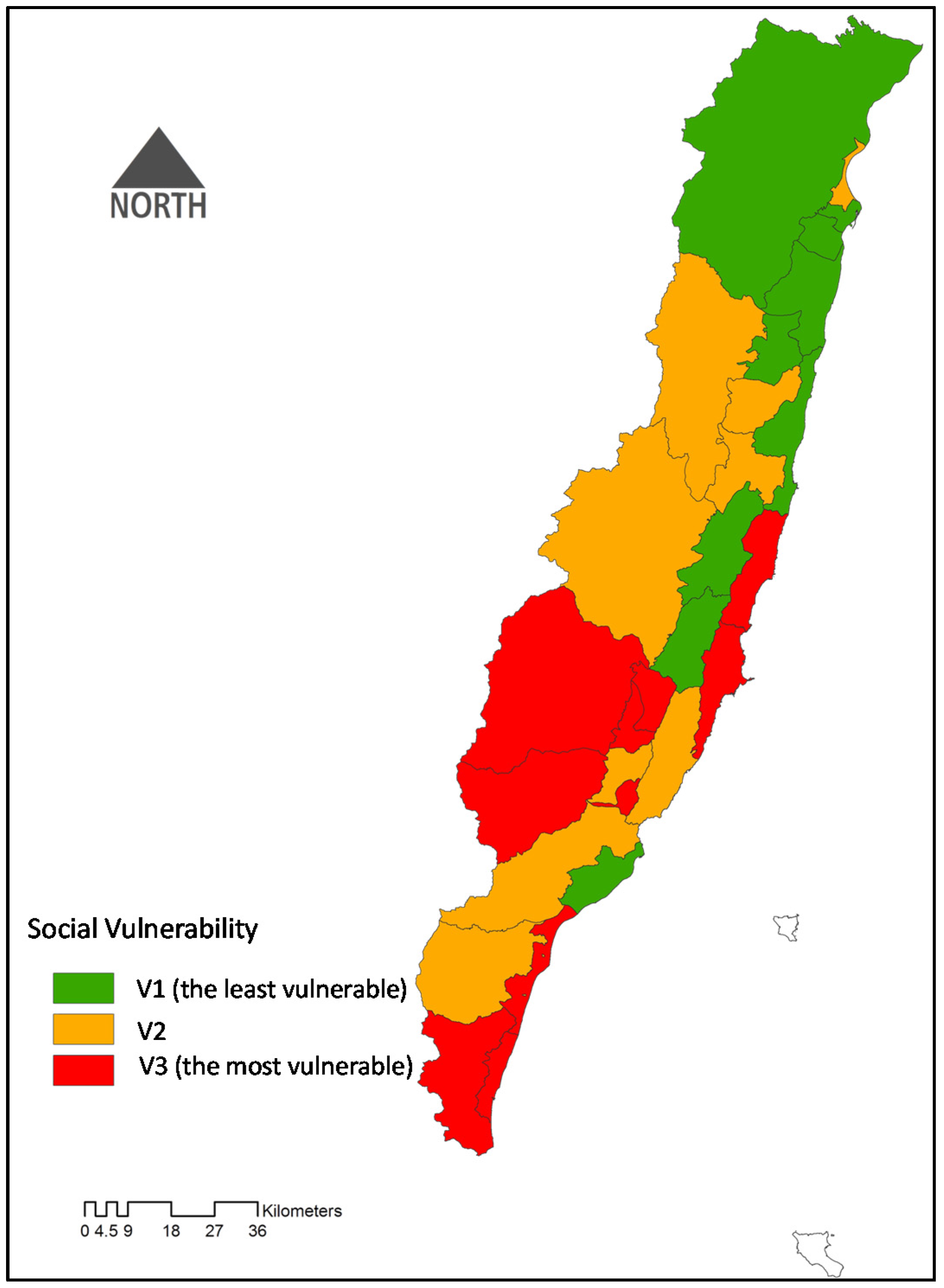Mapping Cross-Boundary Climate Change Vulnerability—Case Study of the Hualien and Taitung Area, Taiwan
Abstract
:1. Introduction
2. Literature Review
2.1. Environmental Change and Vulnerability
2.2. Adaptation Strategy
2.2.1. Adaptation Strategies in Taiwan
2.2.2. Cross-Boundary Spatial Governance and Climate Change

3. Study Area

4. Research Method
4.1. Biophysical Vulnerability Index
4.2. Social Vulnerability Index

| Layer 1 (Dimension) | Layer 2 (Factor) | Layer 3 (Variable) |
|---|---|---|
| Degree of Exposure | Industry | Total product from the agriculture, forestry, and fishing industries |
| Total product from the industrial and commercial industries | ||
| Household asset | Household and building value | |
| Population | Households protected from mudslides by the Water Conservation Bureau (Actual number of occupants) | |
| Household population | ||
| Mitigation response | Prevention engineering | Rate of shock-proof from Taiwan Earthquake Loss Estimation System (TELES) construction data |
| Quantity of engineering for watershed conservation and flood prevention | ||
| Regulations and enforcement | Rate of hillside overuse | |
| Visit and interview results | ||
| Disaster prevention education | Number of mudslide prevention drills | |
| Response Capacity | Refuge shelter | Number of country roads connected to main roads |
| Occupancy rate | ||
| Disaster disadvantaged | Number of elderly people living alone | |
| Number of handicapped people | ||
| Number of welfare organizations for old people | ||
| Rescue | Number of organizations for handicapped people | |
| Number of fire fighters (including volunteer fire fighters) | ||
| Health Care | Number of disaster relief vehicles, ambulances and lifeboats | |
| Area of service for each hospital | ||
| Number of medical people | ||
| Number of hospital beds | ||
| Recovery capacity | Economics | Number of low-income households |
| Rate of recovery time | ||
| Typhoon and flood insurance rates | ||
| Earthquake insurance rate for housing | ||
| Grants and other sources of revenue income assistance | ||
| Social network | Ratio of social welfare budget to people |
5. Results
5.1. Biophysical Vulnerability

| County | Township | Debris Slide % | Rock Slide % | Landslide % | Falling Rocks % | Dip Slope % | Rainfall (600mm/24hr) Flooding % | Tsunami % | Spatial Weights % |
|---|---|---|---|---|---|---|---|---|---|
| Taitung County | Changbin | 1.91% | 0.12% | 0.03% | 1.82% | 1.33% | 0.13% | 1.02% | 0.91% |
| Haiduan | 4.42% | 0.15% | 0.06% | 0.24% | 0.29% | - | - | 0.74% | |
| Chishang | 0.85% | 0.42% | 0.03% | 0.02% | - | 4.12% | - | 0.78% | |
| Chenggong | 2.18% | 0.00% | 0.18% | 0.86% | 1.25% | 0.14% | 2.62% | 1.03% | |
| Guanshan | 0.53% | 0.27% | 0.47% | 0.00% | - | 2.96% | - | 0.60% | |
| Donghe | 3.06% | 0.04% | 0.21% | 0.39% | 2.40% | - | 0.60% | 0.96% | |
| Luye | 2.78% | 0.40% | 0.15% | - | 1.45% | 2.50% | - | 1.04% | |
| Yanping | 6.01% | - | 0.02% | 1.16% | 0.39% | 0.07% | - | 1.09% | |
| Beinan | 2.15% | - | 0.25% | 0.47% | 0.33% | 0.15% | 0.10% | 0.49% | |
| Taitung | 0.02% | - | 0.08% | 0.00% | - | 10.35% | 5.66% | 2.30% | |
| Taimali | 0.20% | - | 0.41% | 0.04% | 1.38% | 3.59% | 0.91% | 0.93% | |
| Ludao | - | - | - | - | - | - | - | 0.00% | |
| Jinfeng | 4.64% | 0.01% | 0.03% | 0.45% | 0.37% | 0.14% | - | 0.81% | |
| Daren | 3.18% | 0.06% | 0.07% | 0.08% | 0.81% | 0.55% | 0.15% | 0.70% | |
| Dawu | 0.93% | - | 1.05% | 0.11% | 0.97% | 3.40% | 1.31% | 1.11% | |
| Lanyu | - | - | - | - | - | - | - | 0.00% | |
| Hualien County | Xiulin | 4.11% | 0.09% | 0.09% | 2.18% | 0.84% | - | 0.07% | 1.05% |
| Xincheng | 0.00% | - | 0.02% | - | - | 9.46% | 1.42% | 1.56% | |
| Hualien | - | - | 0.16% | - | - | 17.25% | 9.46% | 3.84% | |
| Ji’an | 0.03% | - | 0.27% | 0.01% | - | 5.47% | 2.21% | 1.14% | |
| Shoufeng | 0.51% | 0.01% | 0.11% | 0.15% | 0.45% | 4.96% | 0.39% | 0.94% | |
| Wanrong | 3.81% | 0.01% | 0.04% | 1.31% | 0.97% | - | - | 0.88% | |
| Fenglin | 0.08% | 0.02% | 0.25% | 0.00% | 0.18% | 7.38% | - | 1.13% | |
| Fengbin | 3.07% | 0.08% | 0.18% | 0.37% | 2.95% | - | 1.20% | 1.12% | |
| Guangfu | 0.96% | - | 0.48% | 0.05% | 2.40% | 5.74% | - | 1.37% | |
| Zhuoxi | 2.99% | 0.01% | 0.05% | 0.09% | 0.22% | - | - | 0.48% | |
| Ruisui | 1.38% | 0.14% | 0.17% | 0.15% | 3.19% | 0.31% | - | 0.76% | |
| Yuli | 1.20% | 0.22% | 0.26% | 0.15% | 0.39% | 0.50% | - | 0.39% | |
| Fuli | 1.16% | 0.00% | 0.09% | 0.70% | 0.15% | - | - | 0.30% |
5.2. Social Vulnerability

5.3. Synthesized Analysis of Biophysical and Social Vulnerability
| Vulnerability | Social Vulnerability | |||
|---|---|---|---|---|
| Low | Medium | High | ||
| Biophysical Vulnerability | Low | V1 | V2 | V3 |
| Yuli, Fuli in Hualien County | Ruisui, Zhuoxi in Hualien County; Beinan in Taitung County | Daren, Chishang, Guanshan, Haiduan in Taitung County | ||
| Medium | V2 | V3 | V4 | |
| Xiulin, Shoufeng in Hualien County | Wanrong in Hualien County; Luye, Donghe, Jinfeng in Taitung County; | Chenggong, Taimali, Changbin Taitung County | ||
| High | V3 | V4 | V5 | |
| Hualien, Ji’an, Fenglin, Fengbin in Hualien County; Taitung in Taitung County | Xincheng, Guangfu in Hualien County | Yanping, Dawu in Taitung County | ||
| Note: Synthesized vulnerability: V5 > V4 > V3 > V2 > V1 | ||||

5.4. Combining Vulnerability and Key Issues to Develop Local Hotspot Adaptation Strategies and Action Plans
| Adaptation Field | Cross-Boundary Adaptation Strategy | Type |
|---|---|---|
| Disaster | 1. Strengthen cross-boundary disaster response systems | A |
| 2. Monitor and change the location of a disaster and respond to it | C | |
| Infrastructure | 1. Strengthen the backup, recovery, and emergency response plans for life-supporting facilities in neighboring townships | B |
| 2. Assess whether transportation routes in coastal regions in the Hualien and Taitung counties are secure against coastal erosion threats, and develop response measures | B | |
| Agricultural Production and Biodiversity | 1. Strengthen the allocation of agricultural resources between the two counties | B |
| 2. Monitor cross-border biodiversity | B | |
| Land Use | 1. Strengthen water conservation and disaster-prevention facilities | B |
| 2. Adjust regional land uses according to disaster monitoring results | B | |
| Coastal zones | 1. Monitor coastal regions in Hualien and Taitung | B |
| 2. Review and improve the protection capacity of coastal facilities | A | |
| 3. Strengthen natural ecological restoration and conservation in coastal regions | A | |
| Health | 1. Strengthen the monitoring of mosquitoes and impact assessment | B |
| 2. Strengthen epidemic prevention and notification mechanisms | A | |
| Energy Supply and Industry | 1. Cross-county plan for responses to power outages | C |
| Water Resource | 1. Acquire information for the total amount of water in resources in Hualien and Taitung, and predict drought possibilities | C |
| 2. Acquire information for the total number of water resources, and manage and adjust methods of agricultural production | B | |
| 3. Catchment monitoring plan | C | |
| 4. Implement catchment environmental protection and ecological conservation measures | A |
6. Conclusions
Acknowledgments
Author Contributions
Conflicts of Interest
References
- Ahsan, M.N.; Takeuchi, K. The dynamics among poverty, vulnerability, and resilience: Evidence from coastal Bangladesh. Nat. Hazards. 2015. [Google Scholar] [CrossRef]
- Andersson-Sköld, Y.; Thorsson, S.; Rayner, D.; Lindberg, F.; Janhall, S.; Jonsson, A.; Moback, U.; Bergman, R.; Granberg, M. An integrated method for assessing climate-related risks and adaptation alternatives in urban areas. Clim. Risk Manag. 2015, 7, 31–50. [Google Scholar] [CrossRef]
- Archer, D.; Almansi, F.; DiGregorio, M.; Roberts, D.; Sharma, D.; Syam, D. Moving towards inclusive urban adaptation: Approaches to integrating community-based adaptation to climate change at city and national scale. Clim. Dev. 2014, 6, 345–356. [Google Scholar]
- Intergovernmental Panel on Climate Change (IPCC). Summary for Policymakers. Available online: http://epic.awi.de/37531/1/WG2AR5_SPM_FINAL-2.pdf (accessed on 4 January 2016).
- Lee, Y.-J. Climate adaptation planning in coastal areas of Chiayi County, Taiwan. In Proceedings of the International Conference on Energy, Environmental & Sustainable Ecosystem Development (EESED 2015), Kunming, China, 21–23 August 2015.
- National Disaster Council (NDC). National Climate Change Adaptation Action Plan 2013–2017; NDC: Taipei, Taiwan, 2014. (In Chinese) [Google Scholar]
- Hsu, H.-H.; Chou, C.; Wu, Y.-C.; Lu, M.-M.; Chen, C.-T.; Chen, Y.-M. Climate Change in Taiwan: Scientific Report 2011 (Summary); National Science Council: Taipei, Taiwan, 2011. [Google Scholar]
- Preston, B.L.; Yuen, E.J.; Warburton, R.M. Putting vulnerability to climate change on the map: A review of approaches, benefits and risks. Sustain. Sci. 2011, 6, 177–202. [Google Scholar]
- Intergovernmental Panel on Climate Change (IPCC). Climate Change 2013: The Physical Science Basis; Cambridge University Press: Cambridge, UK; New York, NY, USA, 2013. [Google Scholar]
- Jabareen, Y. The Risk City: Cities Countering Climate Change: Emerging Planning Theories and Practices around the World; Springer International Publishers: New York, NY, USA, 2015. [Google Scholar]
- Jabareen, Y. Planning the resilient city: Concepts and strategies for coping with climate change and environmental risk. Cities 2013, 31, 220–229. [Google Scholar]
- Lee, Y.-J. Social vulnerability indicators as a sustainable planning tool. Environ. Impact Assess. Rev. 2014, 44, v31–v42. [Google Scholar] [CrossRef]
- Khailania, D.K.; Pererab, R. Mainstreaming disaster resilience attributes in local development plans for the adaptation to climate change induced flooding: A study based on the local plan of Shah Alam City, Malaysia. Land Use Policy 2013, 30, 615–627. [Google Scholar]
- Jha, A.K.; Miner, T.W.; Stanton-Geddes, Z. Building Urban Resilience: Principles, Tools, and Practice. Directions in Development; World Bank: Washington, DC, USA, 2013. [Google Scholar]
- Kelman, I.; Gaillard, J.C.; Mercer, J. Climate change’s role in disaster risk reduction’s future: Beyond vulnerability and resilience. Int. J. Disaster Risk Sci. 2015, 6, 21–27. [Google Scholar] [CrossRef]
- Bennett, N.J.; Dearden, P.; Peredo, A.M. Vulnerability to multiple stressors in coastal communities: A study of the Andaman coast of Thailand. Clim. Dev. 2014. [Google Scholar] [CrossRef]
- Jabareen, Y. An assessment framework for cities coping with climate change: The case of New York City and its PlaNYC 2030. Sustainability 2014, 6, 5898–5919. [Google Scholar]
- Menoni, S.; Molinari, D.; Parker, D.; Balio, F.; Tapsell, S. Assessing multifaceted vulnerability and resilience in order to design risk–mitigation strategies. Nat. Hazards 2012, 64, 2057–2082. [Google Scholar] [CrossRef]
- Vogel, C.; Moser, S.C.; Kasperson, R.E.; Dabelko, G.D. Linking vulnerability, adaptation, and resilience science to practice: Pathways, players, and partnerships. Glob. Environ. Chang. 2007, 17, 349–364. [Google Scholar] [CrossRef]
- Aretano, R.; Semeraro, T.; Petrosillo, I.; de Marco, A.; Pasimeni, M.R.; Zurlini, G. Mapping ecological vulnerability to fire for effective conservation management of natural protected areas. Ecol. Model. 2015, 295, 163–175. [Google Scholar] [CrossRef]
- Sajjad, H; Jain, P. Assessment of socio-economic vulnerabilities among urban migrants in South-East Delhi, India. J. Stud. Soc. Sci. 2014, 7, 65–81. [Google Scholar]
- Khan, S. Vulnerability assessments and their planning implications: A case study of the Hutt Valley, New Zealand. Nat. Hazards. 2012, 64, 1587–1607. [Google Scholar] [CrossRef]
- Marshall, N.A.; Marshall, P.A.; Tamelander, J.; Obura, D.; Malleret-King, D.; Cinner, J.E. A Framework for Social Adaptation to Climate Change: Sustaining Tropical Coastal Communities and Industries; International Union for Conservation of Nature (IUCN): Washington, DC, USA, 2010. [Google Scholar]
- Burton, I.; Kates, R.W.; White, G.F. The Environment as Hazard; Oxford University Press: Oxford, UK, 1978. [Google Scholar]
- Bizikova, L.; Habtezion, Z.; Bellali, J.; Diakhit, M.M.; Pintér, L. Vulnerability and Climate Change Impact Assessments for Adaptation. Available online: http://www.unep.org/ieacp/files/pdf/ClimateChange_Manual_Final.pdf (accessed on 4 January 2016).
- Rosenzweig, C.; Solecki, W.D.; Hammer, S.A.; Mehrohtra, E. Climate Change and Cities First Assessment Report of the Urban Climate Change Research Network; Urban Climate Change Research Network Center for Climate Systems Research Earth Institute: Columbia University, New York, NY, USA, 2011. [Google Scholar]
- Japan Ministry of the Environment. Report of Influence of Global Warming/Adaptation Research Committee, Ministry of Environment; Japan Ministry of the Environment, Adaptation Research Committee: Tokyo, Japan, 2008.
- National Disaster Council (NDC). Adaptation Strategy to Climate Change in Taiwan; NDC: Taipei, Taiwan, 2012. (In Chinese) [Google Scholar]
- National Disaster Council (NDC). Planning Guidelines for the Adaptation Plan to Climate Change for the Local Governments in Taiwan; NDC: Taipei, Taiwan, 2012. (In Chinese) [Google Scholar]
- Swart, R.; Biesbroek, R.; Binnerup, S.; Carter, T.R.; Cowan, C.; Henrichs, T.; Loquen, S.; Mela, H.; Morecroft, M.; Reese, M.; et al. Europe Adapts to Climate Change: Comparing National Adaptation Strategies; PEER Report No. 1; Partnership for European Environmental Research: Helsinki, Finland, 2009. [Google Scholar]
- Ministry of Housing, Spatial Planning and the Environment, Ministry of Transport, Public Works and Water Management, Ministry of Agriculture, Nature and Food Quality, Ministry of Economic Affairs. National Programme for Spatial Adaptation to Climate Change. Available online: http://www.climatechangesspatialplanning.nl/gfx_content/documents/documentation/National_Adaptation_Strategy_The_Netherlands.pdf (accessed on 4 January 2016).
- Allmendinger, P.; Haughton, G. Spatial planning, devolution, and new planning spaces. Environ. Plan. C 2010, 28, 803–818. [Google Scholar] [CrossRef]
- UNDP. Adaptation Policy Frameworks for Climate Change (APF); Cambridge University Press: Cambridge, UK, 2004. [Google Scholar]
- Liu, M.-D.; Xu, Y.-Z. Cross-boundary Cooperation Model and Case Analysis of Local Governments - Comparison between Taiwan and Germany. Public Adm. Rep. 2011, 41, 37–72. (In Chinese) [Google Scholar]
- Jabareen, Y. Sustainable urban forms: Their typologies, models, and concepts. J. Plan. Educ. Res. 2006, 26, 38–52. [Google Scholar] [CrossRef]
- Aylett, A. Institutionalizing the urban governance of climate change adaptation: Results of an international survey. Urban Clim. 2015, 14, 4–16. [Google Scholar] [CrossRef]
- National Disaster Council (NDC). Strategic Plan for National Spatial Development; NDC: Taipei, Taiwan, 2010. (In Chinese) [Google Scholar]
- Carmin, J.; Anguelovski, I.; Roberts, D. Urban climate adaptation in the global south: Planning in an emerging policy domain. J. Plan. Educ. Res. 2012, 32, 18–32. [Google Scholar] [CrossRef]
- National Disaster Council (NDC). Sustainable Development Strategic Plan for Hualien and Taitung Areas; NDC: Taipei, Taiwan, 2012. (In Chinese) [Google Scholar]
- Dewan, T.H. Societal impacts and vulnerability to floods in Bangladesh and Nepal. Weather Clim. Extrem. 2015, 7, 36–42. [Google Scholar] [CrossRef]
- Schöpfel, J.; Farace, D.J. Grey literature. In Encyclopedia of library and information sciences, 3rd ed.; Bates, M.J., Maack, M.N., Eds.; CRC Press: Boca Raton, FL, USA, 2010; pp. 2029–2039. [Google Scholar]
- The National Science and Technology Center for Disaster Reduction (NCDR). Disaster potential map. Available online: http://www.ey.gov.tw/en/Dictionary_Content.aspx?n=A240F8389D824425&sms=D8F3EB15472D7847&s=60D0017E5CD0B6E4 (accessed on 21 December 2015).
© 2016 by the authors; licensee MDPI, Basel, Switzerland. This article is an open access article distributed under the terms and conditions of the Creative Commons by Attribution (CC-BY) license (http://creativecommons.org/licenses/by/4.0/).
Share and Cite
Lee, Y.-J.; Lin, S.-C.; Chen, C.-C. Mapping Cross-Boundary Climate Change Vulnerability—Case Study of the Hualien and Taitung Area, Taiwan. Sustainability 2016, 8, 64. https://doi.org/10.3390/su8010064
Lee Y-J, Lin S-C, Chen C-C. Mapping Cross-Boundary Climate Change Vulnerability—Case Study of the Hualien and Taitung Area, Taiwan. Sustainability. 2016; 8(1):64. https://doi.org/10.3390/su8010064
Chicago/Turabian StyleLee, Yung-Jaan, Shih-Chien Lin, and Chiao-Chi Chen. 2016. "Mapping Cross-Boundary Climate Change Vulnerability—Case Study of the Hualien and Taitung Area, Taiwan" Sustainability 8, no. 1: 64. https://doi.org/10.3390/su8010064
APA StyleLee, Y.-J., Lin, S.-C., & Chen, C.-C. (2016). Mapping Cross-Boundary Climate Change Vulnerability—Case Study of the Hualien and Taitung Area, Taiwan. Sustainability, 8(1), 64. https://doi.org/10.3390/su8010064





